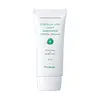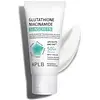What's inside
What's inside
 Key Ingredients
Key Ingredients

 Benefits
Benefits

 Concerns
Concerns

 Ingredients Side-by-side
Ingredients Side-by-side

Water
Skin ConditioningDibutyl Adipate
EmollientPropanediol
SolventMethylpropanediol
SolventTerephthalylidene Dicamphor Sulfonic Acid
UV Absorber1,2-Hexanediol
Skin ConditioningEthylhexyl Triazone
UV AbsorberNiacinamide
SmoothingPolymethylsilsesquioxane
Polysilicone-15
UV FilterAdipic Acid
BufferingTromethamine
BufferingCaprylyl Methicone
Skin ConditioningCetearyl Alcohol
EmollientDiethylamino Hydroxybenzoyl Hexyl Benzoate
UV FilterPolyglyceryl-3 Distearate
EmulsifyingMethyl Trimethicone
Skin ConditioningBis-Ethylhexyloxyphenol Methoxyphenyl Triazine
Skin ConditioningGlyceryl Stearate
EmollientPotassium Cetyl Phosphate
EmulsifyingAcrylates/C10-30 Alkyl Acrylate Crosspolymer
Emulsion StabilisingVp/Va Copolymer
Polyether-1
Carbomer
Emulsion StabilisingDimethicone/Vinyl Dimethicone Crosspolymer
Skin ConditioningGlyceryl Stearate Citrate
EmollientPolyacrylate Crosspolymer-6
Emulsion StabilisingParfum
MaskingDimethicone Crosspolymer
Emulsion StabilisingAdenosine
Skin ConditioningDisodium EDTA
Centella Asiatica Leaf Extract
Skin ConditioningLinalool
PerfumingHexyl Cinnamal
PerfumingCentella Asiatica Extract
CleansingSodium Hyaluronate
HumectantPiper Nigrum Fruit Oil
MaskingCitrus Aurantium Dulcis Peel Oil
MaskingCitrus Limon Peel Oil
MaskingCitrus Nobilis Peel Oil
MaskingWater, Dibutyl Adipate, Propanediol, Methylpropanediol, Terephthalylidene Dicamphor Sulfonic Acid, 1,2-Hexanediol, Ethylhexyl Triazone, Niacinamide, Polymethylsilsesquioxane, Polysilicone-15, Adipic Acid, Tromethamine, Caprylyl Methicone, Cetearyl Alcohol, Diethylamino Hydroxybenzoyl Hexyl Benzoate, Polyglyceryl-3 Distearate, Methyl Trimethicone, Bis-Ethylhexyloxyphenol Methoxyphenyl Triazine, Glyceryl Stearate, Potassium Cetyl Phosphate, Acrylates/C10-30 Alkyl Acrylate Crosspolymer, Vp/Va Copolymer, Polyether-1, Carbomer, Dimethicone/Vinyl Dimethicone Crosspolymer, Glyceryl Stearate Citrate, Polyacrylate Crosspolymer-6, Parfum, Dimethicone Crosspolymer, Adenosine, Disodium EDTA, Centella Asiatica Leaf Extract, Linalool, Hexyl Cinnamal, Centella Asiatica Extract, Sodium Hyaluronate, Piper Nigrum Fruit Oil, Citrus Aurantium Dulcis Peel Oil, Citrus Limon Peel Oil, Citrus Nobilis Peel Oil
Water
Skin ConditioningEthylhexyl Methoxycinnamate
UV AbsorberButylene Glycol
HumectantEthylhexyl Salicylate
UV AbsorberOctocrylene
UV AbsorberBis-Ethylhexyloxyphenol Methoxyphenyl Triazine
Skin ConditioningButyl Methoxydibenzoylmethane
UV AbsorberDipropylene Glycol
HumectantNiacinamide
SmoothingSqualane
EmollientC14-22 Alcohols
Emulsion Stabilising1,2-Hexanediol
Skin ConditioningPolyglyceryl-2 Stearate
EmulsifyingPropanediol
SolventHydroxyacetophenone
AntioxidantGlyceryl Stearate
EmollientStearyl Alcohol
EmollientC12-20 Alkyl Glucoside
EmulsifyingTromethamine
BufferingCentella Asiatica Extract
CleansingCarbomer
Emulsion StabilisingMelaleuca Alternifolia Leaf Extract
PerfumingHippophae Rhamnoides Fruit Extract
Skin ConditioningVitis Vinifera Fruit Extract
Skin ConditioningAcrylates/C10-30 Alkyl Acrylate Crosspolymer
Emulsion StabilisingUncaria Sinensis Extract
Skin ConditioningGlycerin
HumectantAdenosine
Skin ConditioningDisodium EDTA
Oryza Sativa Bran Extract
Skin ConditioningHydrogenated Phosphatidylcholine
EmulsifyingCaprylic/Capric Triglyceride
MaskingSodium Hyaluronate
HumectantGlucose
HumectantHydrolyzed Collagen
EmollientSucrose Stearate
EmollientGlutathione
Cyclodextrin
AbsorbentCetearyl Alcohol
EmollientCaprylyl Glycol
EmollientBeta-Glucan
Skin ConditioningCaprylhydroxamic Acid
Ethylhexylglycerin
Skin ConditioningAsiatic Acid
Skin ConditioningAsiaticoside
AntioxidantMadecassic Acid
Skin ConditioningMadecassoside
AntioxidantTropolone
Skin ConditioningHyaluronic Acid
HumectantPotassium Hyaluronate
Skin ConditioningWater, Ethylhexyl Methoxycinnamate, Butylene Glycol, Ethylhexyl Salicylate, Octocrylene, Bis-Ethylhexyloxyphenol Methoxyphenyl Triazine, Butyl Methoxydibenzoylmethane, Dipropylene Glycol, Niacinamide, Squalane, C14-22 Alcohols, 1,2-Hexanediol, Polyglyceryl-2 Stearate, Propanediol, Hydroxyacetophenone, Glyceryl Stearate, Stearyl Alcohol, C12-20 Alkyl Glucoside, Tromethamine, Centella Asiatica Extract, Carbomer, Melaleuca Alternifolia Leaf Extract, Hippophae Rhamnoides Fruit Extract, Vitis Vinifera Fruit Extract, Acrylates/C10-30 Alkyl Acrylate Crosspolymer, Uncaria Sinensis Extract, Glycerin, Adenosine, Disodium EDTA, Oryza Sativa Bran Extract, Hydrogenated Phosphatidylcholine, Caprylic/Capric Triglyceride, Sodium Hyaluronate, Glucose, Hydrolyzed Collagen, Sucrose Stearate, Glutathione, Cyclodextrin, Cetearyl Alcohol, Caprylyl Glycol, Beta-Glucan, Caprylhydroxamic Acid, Ethylhexylglycerin, Asiatic Acid, Asiaticoside, Madecassic Acid, Madecassoside, Tropolone, Hyaluronic Acid, Potassium Hyaluronate
 Reviews
Reviews

Ingredients Explained
These ingredients are found in both products.
Ingredients higher up in an ingredient list are typically present in a larger amount.
1,2-Hexanediol is a synthetic liquid and another multi-functional powerhouse.
It is a:
- Humectant, drawing moisture into the skin
- Emollient, helping to soften skin
- Solvent, dispersing and stabilizing formulas
- Preservative booster, enhancing the antimicrobial activity of other preservatives
Acrylates/C10-30 Alkyl Acrylate Crosspolymer is a synthetic polymer. It is used to thicken and improve the texture of products. Due to its properties, it can prevent water and oil ingredients from separating.
Adenosine is in every living organism. It is one of four components in nucleic acids that helps store our DNA.
Adenosine has many benefits when used. These benefits include hydrating the skin, smoothing skin, and reducing wrinkles. Once applied, adenosine increases collagen production. It also helps with improving firmness and tissue repair.
Studies have found adenosine may also help with wound healing.
In skincare products, Adenosine is usually derived from yeast.
Learn more about AdenosineYou might know this ingredient as Tinosorb S or Bemotrizinol. It is a UV filter that covers both UVA and UVB rays.
This ingredient has two peak UV absorption peaks ( 310 and 340 nm) and is able to absorb both UV-A and UV-B rays. This ingredient works by preventing UV rays from reaching and damaging your skin.
On top of that - it is highly photostable and helps prevent the photodegration of other sunscreen ingredients such as avobenzone.
Tinosorb S is allowed in the EU, Australia, and Asia. It is close to being approved by the FDA and we'll hopefully get this ingredient in the U.S. by late 2025.
Fun fact: Tinosorb S is the most effective UV absorber at maximum concentration (measured by SPF) permitted in the EU.
This ingredient is oil-soluble, so your oil-cleansers will take this right off at night.
Learn more about Bis-Ethylhexyloxyphenol Methoxyphenyl TriazineCarbomer is a polymer of acrylic acid. Its main role is to create a gel consistency.
A high amount of carbomer can cause pilling or balling up of products. Don't worry, most products contain 1% or less of carbomer.
Centella Asiatica Extract (Centella) is derived from an herb native to Southeast Asia. It is famous for its anti-inflammatory and soothing properties.
Centella is rich in antioxidants and amino acids, such as Madecassic Acid and Asiaticoside.
Studies show the compounds in centella help with:
The combination of all these properties makes centella effective at soothing, hydrating, and protecting the skin.
Other great components of centella include Vitamin A, vitamin C, several B vitamins, and Asiatic Acid.
Fun fact: Centella has been used as a medicine and in food for many centuries. As a medicine, it is used to treat burns, scratches, and wounds.
Learn more about Centella Asiatica ExtractCetearyl alcohol is a mixture of two fatty alcohols: cetyl alcohol and stearyl alcohol. It is mainly used as an emulsifier. Emulsifiers help prevent the separation of oils and products. Due to its composition, it can also be used to thicken a product or help create foam.
Cetearyl alcohol is an emollient. Emollients help soothe and hydrate the skin by trapping moisture.
Studies show Cetearyl alcohol is non-toxic and non-irritating. The FDA allows products labeled "alcohol-free" to have fatty alcohols.
This ingredient is usually derived from plant oils such as palm, vegetable, or coconut oils. There is debate on whether this ingredient will cause acne.
Due to the fatty acid base, this ingredient may not be Malassezia folliculitis safe.
Learn more about Cetearyl AlcoholDisodium EDTA plays a role in making products more stable by aiding other preservatives.
It is a chelating agent, meaning it neutralizes metal ions that may be found in a product.
Disodium EDTA is a salt of edetic acid and is found to be safe in cosmetic ingredients.
Learn more about Disodium EDTAGlyceryl Stearate is a mix of glycerin and stearic acid.
It is used to stabilize the mixing of water and oil ingredients. By preventing these ingredients from separating, it can help elongate shelf life. It can also help thicken the product's texture.
As an emollient, it helps soften skin and supports barrier-replenishing ingredients.
In cosmetics, Glyceryl Stearate is often made from vegetable oils or synthetically produced.
This ingredient may not be fungal-acne safe
Fun fact: The human body also creates Glyceryl Stearate naturally.
Learn more about Glyceryl StearateNiacinamide is a multitasking form of vitamin B3 that strengthens the skin barrier, reduces pores and dark spots, regulates oil, and improves signs of aging.
And the best part? It's gentle and well-tolerated by most skin types, including sensitive and reactive skin.
You might have heard of "niacin flush", or the reddening of skin that causes itchiness. Niacinamide has not been found to cause this.
In very rare cases, some individuals may not be able to tolerate niacinamide at all or experience an allergic reaction to it.
If you are experiencing flaking, irritation, and dryness with this ingredient, be sure to double check all your products as this ingredient can be found in all categories of skincare.
When incorporating niacinamide into your routine, look out for concentration amounts. Typically, 5% niacinamide provides benefits such as fading dark spots. However, if you have sensitive skin, it is better to begin with a smaller concentration.
When you apply niacinamide to your skin, your body converts it into nicotinamide adenine dinucleotide (NAD). NAD is an essential coenzyme that is already found in your cells as "fuel" and powers countless biological processes.
In your skin, NAD helps repair cell damage, produce new healthy cells, support collagen production, strengthen the skin barrier, and fight environmental stressors (like UV and pollution).
Our natural NAD levels start to decline with age, leading to slower skin repair, visible aging, and a weaker skin barrier. By providing your skin niacinamide, you're recharging your skin's NAD levels. This leads to stronger, healthier, and younger looking skin.
Another name for vitamin B3 is nicotinamide. This vitamin is water-soluble and our bodies don't store it. We obtain Vitamin B3 from either food or skincare. Meat, fish, wheat, yeast, and leafy greens contain vitamin B3.
The type of niacinamide used in skincare is synthetically created.
Learn more about NiacinamidePropanediol is an all-star ingredient. It softens, hydrates, and smooths the skin.
It’s often used to:
Propanediol is not likely to cause sensitivity and considered safe to use. It is derived from corn or petroleum with a clear color and no scent.
Learn more about PropanediolSodium Hyaluronate is hyaluronic acid's salt form. It is commonly derived from the sodium salt of hyaluronic acid.
Like hyaluronic acid, it is great at holding water and acts as a humectant. This makes it a great skin hydrating ingredient.
Sodium Hyaluronate is naturally occurring in our bodies and is mostly found in eye fluid and joints.
These are some other common types of Hyaluronic Acid:
Learn more about Sodium HyaluronateTromethamine helps balance the pH and improve the texture of a product. It is synthetically created.
As an emulsifier, Tromethamine prevents oil and water ingredients from separating. This helps stabilize the product and elongate a product's shelf life. Tromethamine also makes a product thicker.
Tromethamine helps balance the pH level of a product. Normal pH level of skin is slightly acidic (~4.75-5.5). The acidity of our skin is maintained by our glands and skin biome. Being slightly acidic allows our skin to create an "acid mantle". This acid mantle is a thin barrier that protects our skin from bacteria and contaminants.
Oral Tromethanmine is an anti-inflammatory drug but plays the role of masking, adding fragrance, and/or balancing pH in skincare.
1,3-Propanediol, 2-amino-2-(hydroxymethyl)-
Learn more about TromethamineWater. It's the most common cosmetic ingredient of all. You'll usually see it at the top of ingredient lists, meaning that it makes up the largest part of the product.
So why is it so popular? Water most often acts as a solvent - this means that it helps dissolve other ingredients into the formulation.
You'll also recognize water as that liquid we all need to stay alive. If you see this, drink a glass of water. Stay hydrated!
Learn more about Water